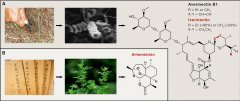Abstract
Decades of previous efforts to develop renal-sparing polyene antifungals were misguided by the classic membrane permeabilization model1. Recently, the clinically vital but also highly renal-toxic small-molecule natural product amphotericin B was instead found to kill fungi primarily by forming extramembraneous sponge-like aggregates that extract ergosterol from lipid bilayers2,3,4,5,6. Here we show that rapid and selective extraction of fungal ergosterol can yield potent and renal-sparing polyene antifungals. Cholesterol extraction was found to drive the toxicity of amphotericin B to human renal cells. Our examination of high-resolution structures of amphotericin B sponges in sterol-free and sterol-bound states guided us to a promising structural derivative that does not bind cholesterol and is thus renal sparing. This derivative was also less potent because it extracts ergosterol more slowly. Selective acceleration of ergosterol extraction with a second structural modification yielded a new polyene, AM-2-19, that is renal sparing in mice and primary human renal cells, potent against hundreds of pathogenic fungal strains, resistance evasive following serial passage in vitro and highly efficacious in animal models of invasive fungal infections. Thus, rational tuning of the dynamics of interactions between small molecules may lead to better treatments for fungal infections that still kill millions of people annually7,8 and potentially other resistance-evasive antimicrobials, including those that have recently been shown to operate through supramolecular structures that target specific lipids9.





